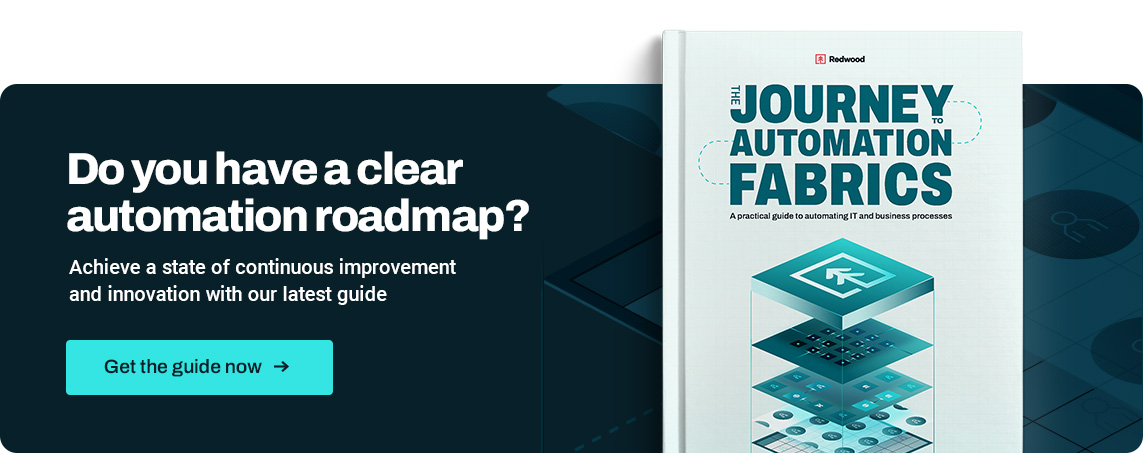The best time to automate? Before, during and after an ERP or cloud transformation

As an organization evolves, so must its infrastructure. So, chances are, you’re no stranger to frequent technology upgrades. You may even be in the midst of a major ERP or cloud transformation.
These large-scale implementations are long-term projects that require both planning and patience. They often bring hope for more streamlined operations, reduced costs and increased operational efficiency. However, these outcomes are far from guaranteed, at least without the all-too-commonly missing piece: automation.
Overlooking automation can bog your systems down in the same inefficiencies and silos you sought to escape with new solutions.
Many IT operations teams treat automation as a separate project — something to think about after the dust settles from a larger tech stack upgrade. But waiting to implement automation is a mistake that can cost time and resources. Embedding automation into your transformation efforts helps with short-term workloads and promotes lasting agility.
Automation: A digital transformation foundation
Whether you’re overhauling your ERP system or migrating to the cloud, you will likely struggle under the weight of inefficient manual processes. With automation as a central component of your transformation strategy, your new technologies have a better chance of delivering on their potential ROI.
Properly integrated, automation enhances the effectiveness of your modernization efforts by:
- Streamlining workflows
- Reducing errors
- Enabling real-time data processing
These improvements to business operations evolve into strategic advantages that enable faster decision-making and more agile responses to business changes. Your entire organization becomes better equipped to anticipate and adapt to demands, regulations and technological advancements.

How automation aligns with your ERP or cloud transformation journey
Let’s break down how automation fits into different phases of your cloud modernization or ERP transition and why you can’t afford to overlook it as you expand your business strategy.
Before: Preparing for success
The planning phase of a cloud or ERP implementation is crucial, and automation can help you create a stable operational environment so you don’t have to worry about cleaning up manual tasks later. Establishing automated processes early streamlines your workflows so your new tech can hit the ground running.
One of the most enticing reasons to think about automation from day one is that it helps you identify even more ways to automate going forward. Not only will you tackle inefficiencies in your current processes, but you’ll also be able to frame new processes in terms of opportunities to automate.
This early groundwork also gives your IT team a chance to define clear automation goals. A proactive approach can save your organization time, effort and headaches later.
Tip: Integrate core systems, such as managed file transfer (MFT) solutions, into your workload automation platform to prioritize data security and important regulatory factors throughout your implementation.
During: While you transform
Cloud migrations and ERP upgrades are resource-intensive processes that require a significant amount of time and effort from your IT team. Automating tasks such as data entry, report generation and system monitoring can free them up to focus on the strategic issues that inevitably arise during a major implementation. Automation during a transformation also serves as a way to validate and test your new technologies to ensure they’re successful.
Business continuity is a big concern in these long projects. If you’ve automated workflows ahead of time, your key processes can remain consistent. And if you’re working on automating them simultaneously, you’re more likely to notice and resolve problems that could create a risk of service interruption or performance lags that impact partner relationships or customer experiences.
Automation is a safety net when you’re in the depths of a software adoption or migration, allowing your business to keep running while you unravel the more challenging elements of scalability and evolving business needs.
Tip: Identify and automate key dependencies early to avoid bottlenecks and improve data consistency across applications. This will drive operational continuity and minimize downtime.
After: Solidifying the gains
A successful cloud transformation or ERP implementation doesn’t end when you go live. To optimize cost savings and meet business objectives with your new technology in place, it’s essential to make automation part of your ongoing operations.
Automating workflows and processes in your new IT infrastructure will allow you to extract value faster. Embedding automation into the day-to-day workings of your ERP system or cloud infrastructure reduces manual workload, improves data accuracy and helps you realize ROI right away. When you’ve put your automations in place before and during a transformation, the transition will feel like a “plug-and-play” scenario.
These short-term benefits set the stage for continuous improvement. Instead of assuming you’ll need another large-scale technology overhaul in the future, you can lay an agile foundation for responding to market demands and driving new initiatives.
Tip: Implement a continuous improvement loop by monitoring system performance, pinpointing opportunities to further streamline and automating updates as needed to keep processes in optimal shape.
Don’t wait to automate
Incorporating automation from the start of your digital transformation journey helps you maximize the potential of your new ERP or cloud environment. By embedding automation across all phases, you generate an agile operational machine.
The best time to automate is now, and your path to long-term ROI starts right where you stand. Determine your stage of automation maturity by taking our quick assessment.
About The Author

Gerben Blom
Gerben Blom has 20 years of expertise in the workload automation space. At Redwood, he has held roles as Principal Product Architect and Product Leader and is now Field CTO for RunMyJobs by Redwood. Considered the global subject matter expert on automation and digital transformation topics, he has a background in implementing and designing customer use cases and abstracting them into product features, enabling the biggest organizations on the planet to achieve their business goals. Gerben has always put the customer first to maximize the value of Redwood solutions in their automation and transformation journeys.
Gerben holds a Master’s in Artificial Intelligence from the University of Groningen, the Netherlands.